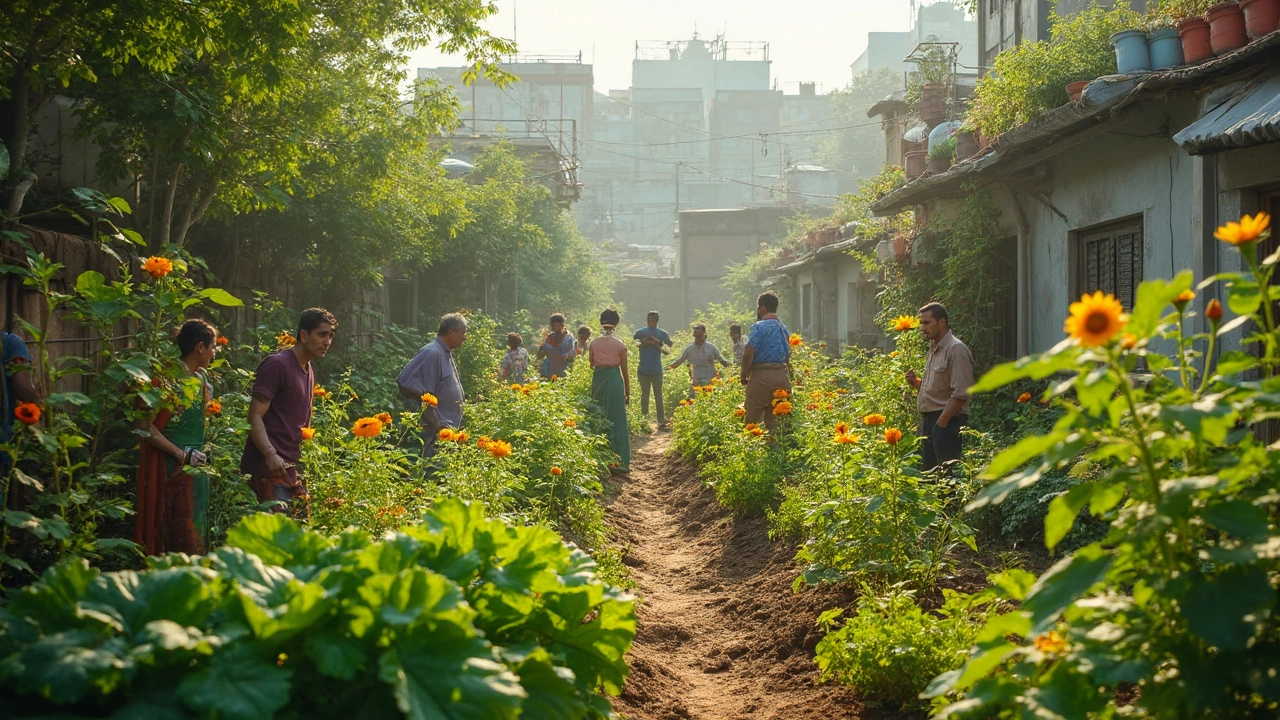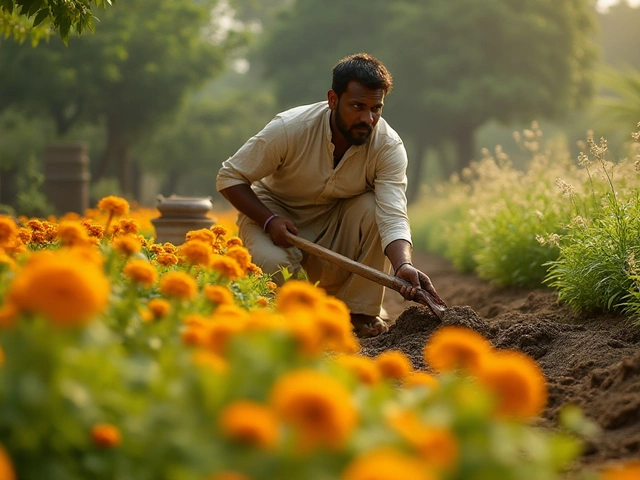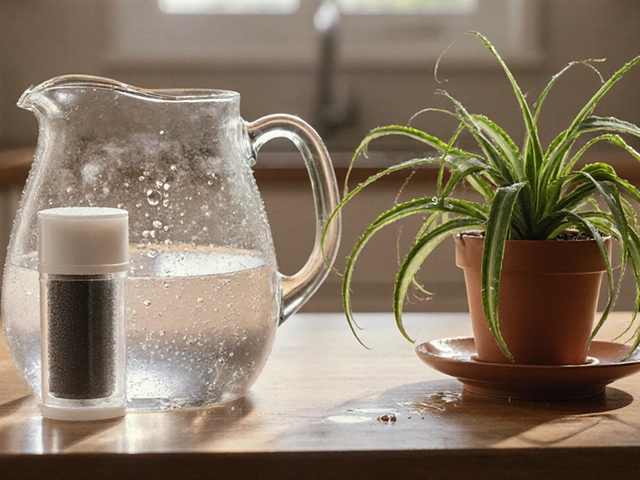Think regenerative agriculture, and visions of cows lazily munching on green grass or chickens scratching away might pop up. But what if you don’t have animals? Or what if you simply don’t want them? There’s a lot of chatter about whether you can truly regenerate soil and build a thriving garden ecosystem without four-legged (or feathered) helpers.
Good news: it’s not only possible—it’s happening in gardens and farms all over the world. People are ditched the goats and the manure, still managing to keep their soils crumbly and packed with worms. Turns out, plants alone have some serious power to rebuild fertility, lock in moisture, and feed the soil life under your feet. But you do need to use a few smart tricks to make sure things don’t fizzle out after a season or two.
If you’re ready to skip the livestock drama, or just want a more low-maintenance setup, animal-free regenerative gardening has options for you. With the right mix of cover crops, mulches, and composts (none from animals), you can boost soil carbon, hold nutrients, and keep weeds down. The key is stacking the right practices—not just relying on one magic bullet.
- Why People Want Animal-Free Regenerative Methods
- What Makes Soil Healthy—With or Without Animals
- Plant-Based Building Blocks: Compost, Mulch, and Green Manures
- Busting the Myths: Do You Always Need Livestock?
- Favorite Tips from Veganic Gardeners
- The Future of Animal-Free Regeneration
Why People Want Animal-Free Regenerative Methods
Not everyone wants cows or chickens in their backyard. There’s a bunch of reasons people look for animal-free farming options, even when they care about regenerative agriculture. First off, space is a big deal. Most home gardeners, and even lots of small farms, just don’t have enough room (or the right zoning) to handle livestock. City gardens? Forget about it—nobody’s sneaking a goat into the community plots without someone noticing.
Then there are lifestyle and ethical choices. Vegan and vegetarian gardeners don’t want to use animal products, period. Some folks have allergies, cultural beliefs, or just don’t want to deal with the mess, noise, or extra work that animals bring. Plus, there’s a bit of double-take happening around the idea that animals are the only ticket to building better soil.
Concerns about emissions and climate change come up too. Animal farming, even on a small scale, creates methane and other greenhouse gases, so some gardeners want a smaller carbon footprint. There’s also disease risk and the time involved—feeding animals, mucking out pens, worrying about predators or escapes. For busy people, just managing plants feels tough enough.
From 2022 data out of the US and Europe, vegan and vegetarians now make up about 8-10% of the population, and many of them grow their own food. According to a 2023 survey by Veganic Agriculture Network, nearly 25% of urban gardeners said they avoid animal inputs on purpose. That’s more than just a passing trend.
| Reason | % of Respondents (Urban Gardeners) |
|---|---|
| Space/Land Limits | 31% |
| Ethics/Diet | 28% |
| Climate Footprint | 16% |
| Time & Labor | 14% |
| Health/Allergy | 11% |
Bottom line: there are plenty of legit motives to try sustainable gardening ideas without livestock. Whether you live in a city or just want a cleaner, simpler routine, animal-free regenerative agriculture is quickly becoming a real thing—no cow pies required.
What Makes Soil Healthy—With or Without Animals
When people talk about healthy soil, they're talking about stuff that's dark, crumbly, and full of life. This isn't just dirt—it's a busy mix of minerals, organic material, bugs, fungi, bacteria, and lots of tiny critters. But does that all depend on animals, or can plants get the job done too? Turns out, the basics of regenerative agriculture and good soil health don’t actually require manure or grazing animals at all.
Here's what really matters for building healthy soil in your garden, animal-free or not:
- Organic matter: This is leftover plant material, compost, leaves, roots—anything that breaks down and feeds the soil. More organic matter means richer soil and a buffet for helpful microbes.
- Soil life: Worms, mycorrhizal fungi, and billions of bacteria turn raw material into nutrients that plants can use. They also help fight off disease and keep the soil loose.
- Cover: Soil that’s covered (either with mulch or green living plants) stays moist, avoids erosion, and shelters all that life underneath.
- Minimal disturbance: Digging or tilling less lets the underground life thrive. It keeps fungi networks intact and helps stop carbon from escaping.
- Diversity: Growing lots of different plants keeps the ecosystem strong. Different roots and leaves provide a wider menu for soil creatures.
Animal farming brings things like manure and grazing impacts, sure. But recent research shows plant-based systems can match or even beat animal-based ones in many ways, if you manage them well. A 2023 study by the Rodale Institute found that gardens using only plant material for compost saw soil organic matter levels rise as much as systems using manure, as long as they kept their soils covered and diversified.
Check out this quick rundown comparing plant-based and animal-based approaches for sustainable gardening:
| Practice | Animal-Based | Plant-Based |
|---|---|---|
| Compost Source | Manure + bedding | Leaves, straw, veggie scraps |
| Fertility Cycle | Animals eat, produce manure | Plants grow, get chopped/dropped |
| Soil Boosted By | Grazing, manure microbes | Worms, decomposing plant life |
| Weed Control | Poultry, goats graze weeds | Thick mulch, dense plantings |
The big takeaway? You don’t need animals to nail the basics of regenerative agriculture or create super healthy soil. It just means focusing even more on plant residues, smarter cover cropping, and never leaving your ground naked. You can totally win at sustainable gardening following these rules, critters or not.
Plant-Based Building Blocks: Compost, Mulch, and Green Manures
If you want to do regenerative agriculture without animals, your main tools are plants themselves. Instead of hauling manure or letting cows roam, you’ll be focusing on plant-based compost, thick mulches, and living, green covers. These boost soil health just as well—and keep things totally animal-free.
Your first go-to? Plant-based compost. This is basically a heap of garden trimmings, food scraps (no meat or dairy), leaves, and even cardboard. When you mix and turn these, microbes work their magic, turning what would be waste into dark, crumbly stuff packed with nutrients. Research out of Rodale Institute found that plots treated with well-made plant compost actually outperformed some fields fertilized with animal manures, especially for growing leafy greens and root crops. The key: keep your pile moist, layer greens (nitrogen) and browns (carbon), and turn it once a week for air.
- Tip: You don’t need fancy bins. Old pallets or a corner of your yard work fine.
- Shred kitchen scraps and cut grass small for faster breakdown.
- Mix dry leaves for rich carbon—think fall cleanup gold.
Next, let’s talk mulch. Mulch is just a cover for your soil, made from things like straw, chopped leaves, grass clippings, or even shredded newspaper. It keeps moisture in, blocks weeds, and slowly feeds the soil as it breaks down. Harvard researchers found that plots mulched with plant material cut water use by one third and grew 45% more vegetables per square foot than bare dirt. Choose material from your backyard instead of buying bales; free and local is best.
- Add a 2-3 inch layer of mulch after planting—no need to overdo it.
- If slugs show up, swap grass clippings for dryer straw or dry leaves.
- Chop and drop: Every time you trim your plants, just lay the cut stems right back on the ground.
Finally, let’s talk green manures—these are cover crops like clover, vetch, rye, or buckwheat. Instead of pulling them up, you cut them down when they flower and leave the roots in place. The result? You feed the soil, add organic matter, and keep those living roots pumping out sugars for soil microbes. A 2022 study from UC Davis showed sites using green manures increased soil carbon by about 12% over three years. That’s a huge win for long-term fertility, no cows needed.
| Plant-Based Practice | Main Benefit | One Bonus |
|---|---|---|
| Compost (veggie-only) | Nutrient boost | Reduces waste |
| Mulch (leaves, straw) | Soil moisture | Keeps soil cool |
| Green manures | Builds soil carbon | Supports pollinators |
Stacking these methods lets you pretty much do everything animal-free farming promises. And since you’re not relying on outside inputs, it’s often cheap, practical, and doable in any backyard or small farm.

Busting the Myths: Do You Always Need Livestock?
You’ll hear this a lot: “Real regenerative agriculture always includes animals.” It sounds convincing, but it just isn’t true for everyone or every patch of land. Plenty of gardens and even full-sized farms are skipping goats, chickens, or cows and still improving soil health year after year.
The classic argument goes like this—animals graze, poop, trample, and cycle nutrients, making the whole system work better. That’s definitely one way to do it. But animals are not the only way to build up good soil. Plants have their own tricks. Things like cover crops pump carbon into the ground, legume green manures fix nitrogen, and deep mulches feed worms and microbes. All of that can happen with zero livestock in the picture.
Let’s look at some facts:
- Many no-till vegetable farms—like Leek & Thistle in Quebec—don’t have any animals and still see their organic matter climb every year using just plant-based compost and living mulches.
- Research from Rodale Institute shows cover-cropped fields boosted soil structure and water retention just as much as animal-manured ones—sometimes more, especially where cover crops grew all season.
- Urban gardens, where keeping animals isn’t practical, are often the most productive per square foot because they pile on plant trimmings, kitchen scraps, and leaf mulch.
Here’s a quick comparison of two main ways people keep their soil healthy in sustainable gardening:
| With Livestock | Without Livestock |
|---|---|
| Rotational grazing Manure spread every year Animal bedding compost | Cover crops Plant-based compost Leaf and straw mulch |
| More work (handling animals) Needs fences and shelter | No animal chores Works in small spaces and backyards |
You don’t need a herd of anything to keep your land thriving. Anyone with a shovel and a little patience can use animal-free farming tricks and let plants do most of the heavy lifting. Just because something’s always been done a certain way doesn’t mean it’s the only way that works.
Favorite Tips from Veganic Gardeners
People doing regenerative agriculture without animals have dialed in some smart routines. These aren’t vague trends; they’re clear, hands-in-the-dirt hacks that gardeners swear by to build crazy-healthy soil without animal inputs. Here’s what stands out from real veganic growers.
- Never let the soil go bare. Plant cover crops like clover, buckwheat, or winter rye when you’re not growing veggies. This saves moisture, stops erosion, and feeds the living stuff in your dirt. In the heat, summer cover crops like cowpeas and sun hemp work wonders in warm climates.
- Make your own compost—no manure needed. Kitchen scraps, leaves, grass clippings, shredded cardboard, coffee grounds—they all combine to make plant-based compost. Some folks add biochar for an extra soil boost, as it holds onto nutrients and helps microbes thrive.
- Chop & drop is your friend. This means cutting down spent cover crops, weeds, or veggie stalks and leaving them right on the surface. Letting this stuff rot in place creates a mulch layer that soil microbes and worms love.
- Alfalfa pellets and green manures pack a punch. Gardeners often buy organic alfalfa pellets (sold for rabbits and horses) to mix into beds. It’s full of nitrogen and breaks down quickly. Sowing green manures like field peas or vetch fixes nitrogen right in your soil with zero animal byproducts.
- Apply mulches thick and wide. Leaves, straw, wood chips, or even shredded paper help lock in moisture, stop weeds, and add slow-release nutrition as they break down—just skip layers of fresh grass clippings, which can mat and block air.
Some actual growers track their progress, too. For example, a Canadian trial comparing veganic vs. animal-based compost found the veganic beds boosted carrot yields and improved water retention just as much as those using sheep manure. Want to geek out? Here’s a side-by-side stat from one small community garden:
| Compost Type | Carrot Yield (lbs/bed) | Soil Organic Matter (%) |
|---|---|---|
| Plant-Only Compost | 16 | 4.2 |
| Animal Manure Compost | 15.7 | 4.1 |
Does it take a little planning? Sure. But with these repeatable, affordable steps, anyone can nail animal-free farming and still get top-notch soil for their gardens. Just don’t forget: mixing it up and keeping the soil covered is the real game changer.
The Future of Animal-Free Regeneration
If you think regenerative agriculture is just for folks with pastures and cows, think again. Technologies and ideas for animal-free farming are growing fast. More gardeners and farmers are taking the plant-based route—sometimes by choice, sometimes because animals just aren’t an option in smaller spaces or urban areas.
One interesting thing popping up is biofertilizer made without animal parts. Companies are now producing compost teas, green manures, and even microbe-packed teas that come 100% from plants and minerals. These boost soil health fast and get rid of the usual worries about pathogens or antibiotics making their way from animal manures.
Researchers at places like Rodale Institute have found that sustainable gardening with plant-only inputs can hold up in the long run if folks add enough diversity—meaning, lots of cover crops, veggie wastes, and leaf mulches. In some trials, bean and pea cover crops cranked up soil carbon and nitrogen almost as much as chicken or cattle compost.
| Method | Avg. Soil Carbon Increase (3 Years) |
|---|---|
| Legume Cover Crops | +16% |
| Grass-Clipping Mulch | +11% |
| Poultry Manure | +19% |
That means the gap is closing. You don’t have to accept lower yields or sad, tired soils just because you’re skipping the livestock. With new biochar, mycorrhizal inoculants, and precision composting, animal-free farming is catching up tech-wise too. Less mess, fewer regulations, but still all the goodness for your crops.
A few things might slow it down. Gathering enough plant material for compost takes work, and not everyone has free access to tons of leaves or grass. Some nutrients, like phosphorus, can be tricky to replace without animal bones or manures, but smart crop rotations and rock dusts are helping fill those gaps.
Don’t be surprised if, in the next decade, almost every tool or input you see for sustainable gardening has a solid animal-free version on the shelf. The future looks green for both vegans and practical gardeners who just want a good system that works—no chickens required.





